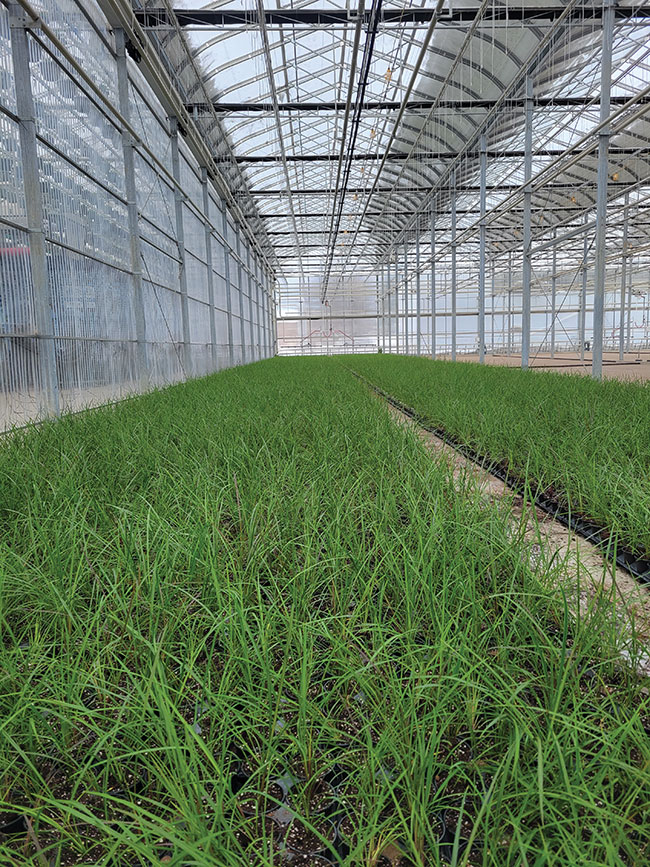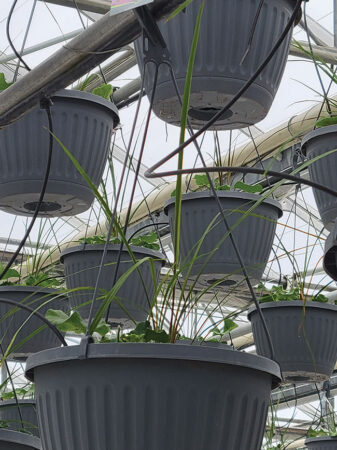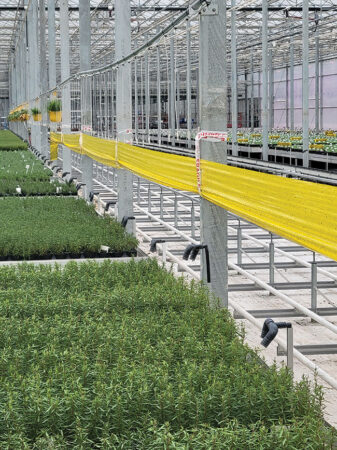
Features
Biocontrols
Crop Protection
Interrupting the Seasonal Pest Pathway
During the brief pause between greenhouse crops, one often overlooked area is pest management.
March 28, 2022 By Mike Short
 As plants are moved out of the greenhouse, adult thrips can migrate to any remaining poinsettia plants or newly arriving product. All photos courtesy of M. Short.
As plants are moved out of the greenhouse, adult thrips can migrate to any remaining poinsettia plants or newly arriving product. All photos courtesy of M. Short. As ornamental greenhouse growers transition from one seasonal crop to another, there is typically a welcome pause in the frantic action that is often defined by endless sorting, packing and loading of trucks. Production managers may use this time to assess the successes and failures of the previous crop and prepare the greenhouse for the next one. However, one area of focus that is often overlooked at this time is pest management.
Even though most of the growing area may be empty, certain pests are already making their next move. The previous crop may have hosted pests that were not of concern as they did not cause economic damage over the course of the season. Once the host plants are removed, these pests may migrate to new locations and continue their life cycle. It is important to understand this in order to combat potential problems as soon as the next crop starts.
From Poinsettia to Spring Crops: A Pest Pathway
One example of this pest migration dynamic is the movement of adult thrips along the poinsettia to spring bedding plant pathway. In August and September when poinsettia plants are at their youngest, thrips are still entering the greenhouse through vents from surrounding areas in high numbers. They tend to settle on poinsettia if other more attractive plant material is limited (e.g., blooming chrysanthemum). Although early feeding damage can occur, the plant will usually grow out of it and hide any deformities after bract initiation. Because of this, controls for thrips (insecticides or biological control) are not usually recommended as this will add to the input cost of an already precarious profit margin. Besides, the grower has enough pest pressure from whiteflies at this point so that should be their focus. Thrips will continue through their life cycle within the crop until shipping or may drop to the floor to pupate as temperatures and daylengths decrease in autumn. As plants are moved out, adult thrips can migrate to remaining poinsettia plants or any newly arriving product, even in their vegetative state.
The Dracaena (spike) is one such plant. They are typically brought into the greenhouse early to grow to size on their own. Alternately, they are commonly used as a centrepiece in mixed hanging baskets or planters for the spring market. Not normally a major thrips host when surrounded by more attractive plant material, thrips will migrate to them if no other suitable plant hosts are available. If thrips move to Dracaena when the poinsettia move out in December, they will have enough time to complete a full life cycle (approximately three weeks at 21°C) before they are transplanted in February. The egg and larval stage of the insect will then be transported with the plants to their final placement in the greenhouse, effectively spreading thrips throughout the growing area. Early control is essential to prevent the buildup of thrips in places like hanging baskets, which can cause additional problems for product on the benches below if populations are allowed to increase.

Dracaena pictured above and in mixed hanging baskets.
Interrupting the Pest Pathway
It is well documented that Western Flower thrips (Frankliniella occidentalis) are attracted to yellow and blue colours of sticky tape. Positioning the yellow or blue tape between the poinsettia growing area and any new plant material will minimize some of the threat. Be sure to replace tape towards the end of the growing season as it fills up with dead insects over time and loses some of its attractiveness. Thrips are more likely to be in flight during this time, so placement of the tape just above the tops of the plants would be most effective.
For Dracaena, direct release of predatory mites is advised. Neoseiulus cucumeris can be applied in a loose bran mixture, however slow-release sachets are best. These will release mites over time, reaching peak numbers in three to four weeks, which is enough to cover the initial life cycle of the migrating insects. If the sachets are touching the growing media, they tend to wick water into the interior thus reducing the product’s effective lifetime. To avoid this, try sachets on sticks.
The final step to interrupting this pest pathway is to place a sachet in each hanging basket or planter when planted, especially if thrips host plants such as Verbena or Calibrachoa are involved.
A word of caution is needed when using biological control for thrips. Onion thrips (Thrips tabaci) have been found on Dracaena. These are not easily controlled by predatory mites, so it is best to identify the species before proceeding with a release. Sprays are still effective against Onion thrips so this remains an option in this case. A helpful thrips identification article is available online at Greenhouse Canada (see digital archives: Jandricic et al., Feb 2020).
An additional method of interrupting thrips migration is to place flowering trap plants near the Dracaena. As long as there are no other competing flowering plants nearby, thrips will be attracted initially to the trap plants. The trick is remembering to remove the traps after two weeks to avoid thrips reproducing on them, which would defeat the purpose. Clean trap plants such as marigolds or Chesapeake varieties of chrysanthemums have been used with great success. Check the activity within blooms of the trap plants two or three days after setting them out, then bag and remove them from the greenhouse if high numbers are found.

Positioning sticky tape between crops will minimize some of the threat from thrips migration.
More to Consider
The seasonal pest pathway highlighted here is only one example of how pests can easily stay in your facility and become a resident problem if not attended to early on. Spring crops that eventually flower (unlike Dracaena), can also be a host for migrating pests and should be monitored for pest pressure when initial blooms appear. Bloom colours such as pink and yellow can be especially attractive to thrips, and individual plants can be bagged and removed early if possible.
Unchecked weed growth can also act as intermediate host sites along the pest pathway. Even when insecticide sprays are used for cleaning up after a crop, weeds can still harbour active populations of pests. It is best to remove weeds along walls, gutters and under benches before applying a cleanup spray. If a new crop has already been placed before existing weeds are removed, there is a risk of pest migration to that area during cleanup.
It is not always easy to determine where pest populations come from in a multiple-crop growing system. Often, incoming plant material is blamed for infestations. This is sometimes true, although as outlined in this article, pests may be following their own pathway through your greenhouse.
Mike Short is the founder of Eco Habitat Agri Services and provides customized IPM consulting services to greenhouses, nursery crops and cannabis operations. Mike can be reached at ecohabitatbio@gmail.com
Print this page